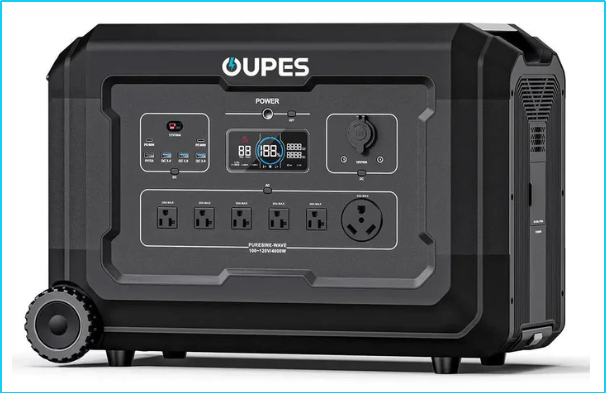
Table of Contents
- TL;DR / Key Takeaways
- Why Identifying the Big Energy Drainers Matters
- The Top Energy-Draining Appliance: Space Heating & Cooling
- Detailed Breakdown of How Much Energy It Uses
- Other Significant Energy Drainers
- What You Can Do About It
- How Solar Panels and Portable Power Stations (like OUPES) Fit In
- Comparison Table: Energy Drainers vs Low-Draw Appliances
- FAQ
TL;DR / Key Takeaways
The appliance category that drains the most electricity in most U.S. homes is space heating and cooling (HVAC systems). They often account for 40–50% of a home’s total electricity consumption. By identifying this “real energy hog,” you can focus your efficiency and solar- + battery-based strategies more effectively.
Why Identifying the Big Energy Drainers Matters
If you want to reduce your electric bill or size a solar + battery system effectively, you must target the loads that consume the most energy. According to the U.S. Energy Information Administration (EIA) and other sources, heating, ventilation and air-conditioning (HVAC) systems dominate residential energy consumption.
Understanding which appliances draw the most energy helps:
- Design a solar/battery system that covers the right loads
- Prioritize efficiency upgrades where they matter most
- Avoid overspending on battery capacity for low-impact loads
The Top Energy-Draining Appliance: Space Heating & Cooling
By a wide margin, climate control systems are the largest energy consumers in homes. Direct Energy reports that heating and cooling can account for about 54% of the average home’s electricity use.
This includes both forced-air systems, heat pumps, furnaces, baseboards, window A/C units, and fans. Because they run for long periods and often at high wattage, they dominate the consumption profile.
Detailed Breakdown of How Much Energy It Uses
Here are some sample values from charts gathered for residential homes:
- A space heater or electric furnace may draw ~1.5 kW per hour or more—meaning ~36 kWh for a 24-hour run. (Silicon Valley Power Chart)
- Water heating alone often accounts for 12–16% of total home electricity use—still high but far less than HVAC. (EnergySage blog)
Since HVAC is used both in summer (cooling) and winter (heating), its impact is year-round. Poor insulation, drafty windows, or inefficient equipment multiply the wastage.
Other Significant Energy Drainers
While HVAC is number-one, the next contenders include:
- Water heaters – often 12–16% of usage. (EnergySage)
- Clothes dryers and ovens – high wattage, especially when heating elements are used. (Renewable Energy World)
- Refrigeration and lighting – daily use, but lower wattage than HVAC and heating.
What You Can Do About It
If HVAC is your biggest drain, you have strong leverage for savings. Consider:
- Improving insulation, sealing air leaks, upgrading windows.
- Upgrading to high-efficiency equipment (e.g., heat pumps, variable speed systems).
- Optimizing thermostat settings and using zoned heating/cooling.
- Scheduling heavy loads when solar or stored energy is available, if you have solar.
How Solar Panels and Portable Power Stations (like OUPES) Fit In
When your primary energy drainer is HVAC usage, pairing solar panels with a properly sized battery can shift part of that load onto your own generation/storage rather than drawing expensive grid electricity.
Portable power stations—such as those offered by the brand OUPES—can:
- Store excess solar or off-peak grid power and discharge during peak HVAC usage.
- Act as backup power for your HVAC systems in an outage, keeping heating/cooling safe when grid fails.
- Help manage loads by running essential HVAC zones rather than entire house, thereby reducing the drain.
When designing a solar+battery system, focus on the biggest drain (HVAC) to size storage and usage strategy. If your battery can support key HVAC zones for several hours, you will reduce your grid dependence and lower your bill significantly.
Comparison Table: Energy Drainers vs Low-Draw Appliances
| Appliance/System | Typical Power Draw / Annual Usage | Relative Impact on Bill |
|---|---|---|
| HVAC / Space heating & cooling | 1–3 kW while running; maybe 40–50% of home's yearly use | Very high – biggest single drain |
| Water heater | 2–4 kW for heating phase; ~12–16% of home use | High |
| Clothes dryer / electric oven | 1.5–3 kW during cycle; usage varies | Moderate to high |
| Refrigerator | ~100–300 W average duty cycle; ~4% of home use | Moderate |
| LED lighting, laptops, small electronics | <100 W each; aggregated maybe 2–5% of home use | Low |
FAQ
1. If HVAC is the main drain, does that mean nothing else matters?
No—while HVAC is the largest, other loads like water heating or dryers can still cause bill spikes. But focusing on HVAC gives the most significant savings potential.
2. Can upgrading to solar alone solve this problem?
Not always. Solar panels reduce generation cost, but unless you shift or store energy for when HVAC loads run (often early morning or evening), you may still pull from the grid. Adding a battery or portable station helps.
3. How do I estimate how much my HVAC uses?
Use your utility usage data, monitor kilowatt-hours during heating/cooling seasons, or get a home energy audit. Many utilities offer breakdowns.
4. Could a portable power station really help with HVAC loads?
Yes—but it must be sized appropriately. If you only power a small zone rather than entire house, a portable station becomes more affordable and effective.
5. Does this apply uniformly across all climates?
Usage patterns differ by climate—homes in very cold or very hot zones see greater HVAC drain. The principle holds: find your biggest load and optimize for it.


























